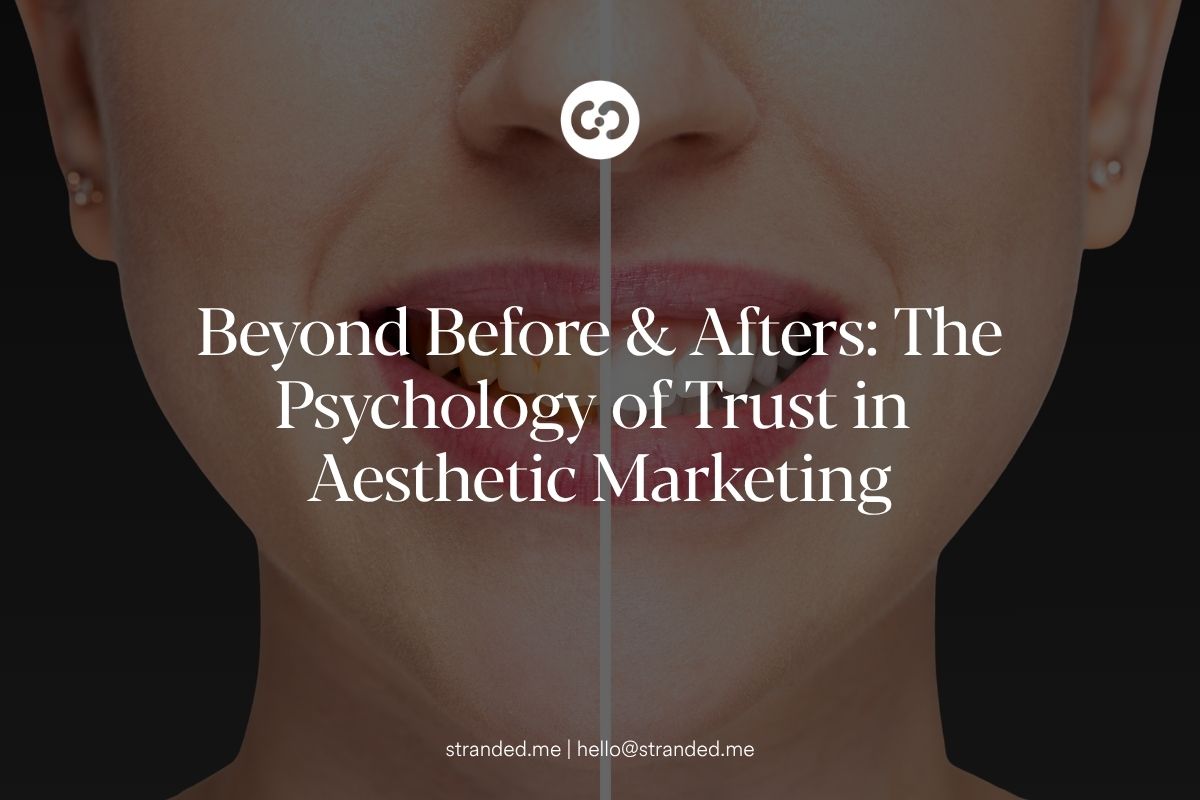
© Stranded
Scroll through any med spa’s Instagram feed and you’ll see the same thing, a carousel of before-and-after photos. While visual proof is important, real trust is built on something deeper: psychology, emotion, and authenticity. In aesthetic marketing, the goal isn’t just to show transformation; it’s to make people believe that transformation is achievable, safe, and guided by experts who care.
Before-and-after imagery has become table stakes. When every competitor shows flawless results, the impact diminishes. Patients today crave authenticity, they want to see relatable outcomes, honest recovery stories, and transparent experiences. Unrealistic perfection triggers skepticism instead of inspiration.
- Over-edited photos reduce credibility and can violate ad policies.
- Contextual storytelling around each case increases emotional connection.
- Diverse representation helps audiences see themselves in your brand.
Every aesthetic decision involves trust: trust in safety, skill, and integrity. Studies show that patients assess competence subconsciously within seconds of seeing your digital presence. Clean design, consistent visuals, and a professional tone signal stability and precision, qualities associated with safe clinical care.
- Use calming color palettes that align with medical trust cues.
- Feature provider credentials and certifications prominently.
- Highlight medical standards, sanitation, and technology details.
Patient narratives evoke empathy and belonging. A real client describing her confidence after acne-scar treatment is more persuasive than any headline. Storytelling creates emotional proof, the bridge between curiosity and conversion. Share authentic journeys with consent and clarity.
- Focus on feelings and motivations, not just procedures.
- Include short quotes or testimonial excerpts in captions.
- Ensure language honors privacy and avoids exaggeration.
Photos remain powerful when used ethically. Maintain consistent lighting, angles, and expression between before and after images. Include disclaimers where required, and avoid unrealistic filters. Google’s EEAT principles reward trustworthy, experience-based content, and so do patients.
- Show genuine outcomes with proper consent documentation.
- Use high-resolution images optimized for accessibility (ALT text matters).
- Label photos clearly: “Individual results may vary.”
Reviews, video testimonials, and influencer collaborations activate social validation, a core behavioral bias. Prospective patients assume that what worked for others will work for them. Incorporating visible proof from real people boosts conversions by up to 40% on average.
- Embed verified Google or RealSelf reviews on key service pages.
- Use first names, not initials, when permitted, for authenticity.
- Combine visuals with written testimonials for layered credibility.
Behind every brand is a human expert. Provider-led communication establishes authority and reassurance. Blog articles, video consultations, and educational posts humanize the medical side of aesthetics, replacing sales pressure with trusted guidance.
- Feature the injector or doctor in short explainer videos.
- Use “I” and “we” statements to personalize education.
- Discuss the science behind treatments in clear, relatable terms.
The most effective aesthetic brands blend aspiration with realism. Patients want hope, but not hype. Position your services as enhancements of natural beauty, not transformations of identity. That nuance cultivates emotional safety and brand loyalty.
You can’t manage what you don’t measure. Track indicators of brand trust, review growth, consultation show rates, repeat booking percentages, and referral volume. When trust improves, marketing costs decline and lifetime value increases.
True aesthetic marketing goes far beyond before-and-after photos. Trust is built through authentic voices, transparent visuals, and consistent emotional alignment. In an era where patients are bombarded by options, those who communicate with honesty and empathy stand apart, and grow faster.
At Stranded, we help aesthetic practices combine psychology, design, and data to create marketing that feels human, and performs. From med spa marketing strategy and SEO to Google Ads and brand storytelling, we help you build trust that lasts.
Book a Free Strategy Session
Yes, but only when used authentically. They should complement patient stories and reviews, not replace them.
Focus on transparent communication, consistent branding, verified reviews, and educational content that demonstrates expertise.
Yes, when it’s grounded in empathy and truth. Ethical storytelling helps patients make informed, confident decisions.
Both matter, but reviews carry more weight for credibility. Patients trust the words of others who’ve had the same experience.